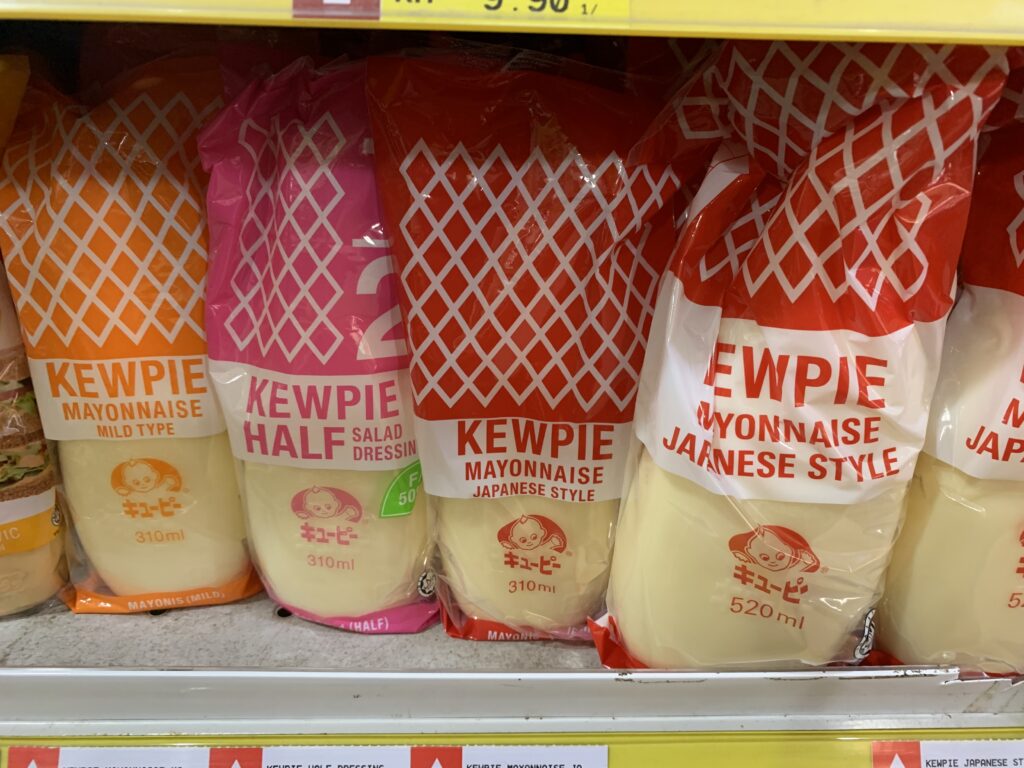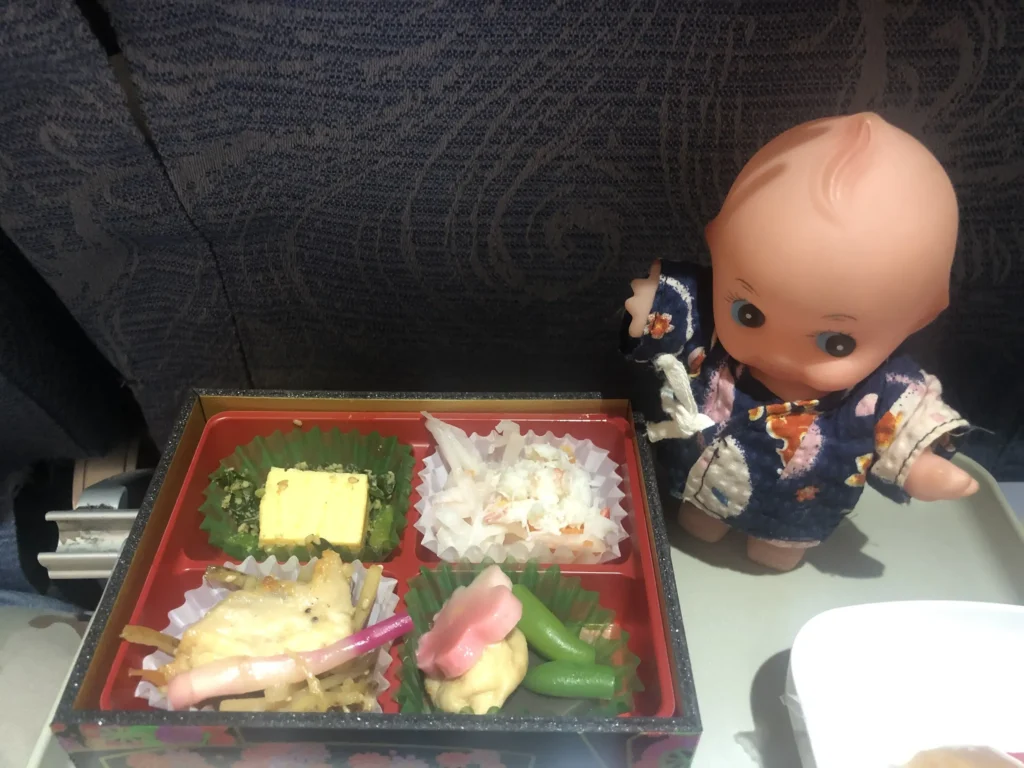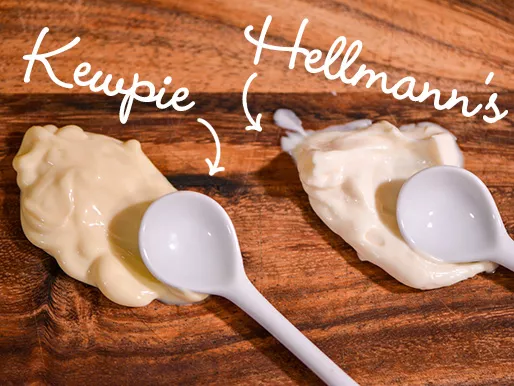Mayonnaise sauce has found a special place in Japanese cuisine, where it has been embraced and transformed into unique regional variations. One brand that stands out in Japan is Kewpie, known for its iconic mayonnaise with its distinct creamy texture and umami-rich flavor. In this post, we will delve into the world of Japanese regional adaptations of mayonnaise sauce, with a focus on the popular Kewpie brand.
For more information about Kewpie character click here

Kewpie: A Beloved Mayonnaise Brand in Japan
Kewpie, a well-established Japanese food company, has played a significant role in popularizing mayonnaise sauce in Japan. Founded in 1925, Kewpie introduced its signature mayonnaise in a distinct bottle with a cute Kewpie doll logo. This branding helped Kewpie mayonnaise gain recognition and become a staple in Japanese households.
What sets Kewpie mayonnaise apart is its creamy texture and rich umami flavor. It is made using a combination of egg yolks, vinegar, vegetable oil, and a touch of MSG (monosodium glutamate), which enhances its savory taste. Kewpie mayonnaise has a smooth and velvety consistency, making it ideal for various culinary applications.

Japanese Mayonnaise: A Flavorful Twist
Japanese mayonnaise, including Kewpie, has its own unique flavor profile that sets it apart from traditional mayonnaise found in other countries. It tends to be slightly sweeter and tangier, with a more pronounced umami taste. The addition of rice vinegar instead of distilled vinegar gives it a milder acidity, allowing the other flavors to shine through.
The umami taste in Japanese mayonnaise is enhanced by the addition of Monosodium glutamate – MSG, which contributes to its distinct flavor. MSG is a flavor enhancer commonly used in Japanese cuisine to elevate the savory notes of dishes. It is important to note that MSG is considered safe for consumption and has been used for decades in various food products.
Kewpie Mayonnaise and Japanese Cuisine
Kewpie mayonnaise is a versatile condiment that is widely used in Japanese cooking. It is an essential ingredient in popular dishes such as Okonomiyaki, a savory pancake, where it is drizzled on top and adds a creamy and tangy element. Takoyaki, another beloved street food, is often served with a generous dollop of Kewpie mayonnaise along with a savory sauce.
Kewpie mayonnaise is also a common accompaniment to sushi and sashimi, where it is used as a dipping sauce or added to sushi rolls to enhance the flavors. Its creamy texture and balanced flavors complement the freshness of the seafood, adding a delightful creaminess to each bite.
Additionally, Kewpie mayonnaise is popular in Japanese salads, such as potato salad and coleslaw. The creamy and tangy nature of Kewpie mayonnaise lends itself well to these dishes, providing a smooth and flavorful dressing.
Regional Variations of Japanese Mayonnaise Sauce
While Kewpie mayonnaise is a ubiquitous brand in Japan, there are also regional variations and adaptations of mayonnaise sauce that reflect local tastes and culinary preferences. For example, in the Kansai region, which includes cities like Osaka and Kyoto, a spicier version of mayonnaise sauce called “Spicy Mayo” is popular. It combines mayonnaise with chili sauce or sriracha to add a fiery kick to dishes like takoyaki or yakisoba.
In Hokkaido, the northernmost region of Japan, there is a variation of mayonnaise sauce known as “Hokkaido-style mayonnaise.” This style of mayonnaise is known for its rich and creamy texture, achieved by using a higher ratio of egg yolks to oil. It is often used in local dishes such as corn butter, where it is mixed with melted butter and brushed onto grilled corn for a decadent and flavorful treat.
In the Kanto region, which includes Tokyo, mayonnaise sauce is often used in combination with soy sauce to create a popular dipping sauce called “Mayo-miso.” This sauce pairs well with grilled meats and vegetables, offering a balance of creaminess from the mayonnaise and savory depth from the miso.
In Okinawa, the southernmost prefecture of Japan, mayonnaise sauce takes on a unique twist with the addition of Okinawan ingredients such as island-grown papaya. This variation, known as “Papaya Mayo,” has a fruity and tangy flavor that adds a tropical touch to dishes like Okinawa soba and stir-fried vegetables.
These regional adaptations of mayonnaise sauce in Japan showcase the versatility and creativity of Japanese cuisine. Each variation adds its own distinct flavors and complements the local dishes, offering a delightful culinary experience.
Incorporating Kewpie Mayonnaise in Home Cooking
Kewpie mayonnaise, with its creamy texture and umami-rich taste, can be a fantastic addition to your home cooking. Whether you want to add a burst of flavor to your salads, sandwiches, or grilled dishes, Kewpie mayonnaise can elevate your culinary creations.
For a quick and easy potato salad, mix boiled potatoes, chopped vegetables, and Kewpie mayonnaise. The creamy texture and tangy flavor of the mayonnaise will bind the ingredients together, creating a delicious side dish.
You can also use Kewpie mayonnaise as a condiment for your favorite sandwiches and burgers. Its creamy texture adds a luscious mouthfeel, and the umami taste enhances the overall flavor profile of your creation.
If you’re feeling adventurous, try making your own spicy mayo by mixing Kewpie mayonnaise with your preferred hot sauce or chili paste. This versatile sauce can be used as a dip, spread, or drizzle to add a kick of heat to various dishes.

Conclusion
Japanese regional variations and adaptations of mayonnaise sauce, particularly the renowned Kewpie brand, have added a unique twist to this beloved condiment. The creamy texture, umami-rich flavor, and versatility of Kewpie mayonnaise make it a popular choice in Japanese cuisine. From street food like Okonomiyaki and Takoyaki to sushi rolls and salads, Kewpie mayonnaise finds its place in a wide range of dishes.
Exploring the regional variations of mayonnaise sauce in Japan allows us to appreciate the diverse culinary landscape and the creativity that goes into adapting a simple condiment to different regional preferences. Whether you’re a fan of Kewpie mayonnaise or want to try new flavor combinations, incorporating Japanese mayonnaise sauces can take your home cooking to the next level.
So, next time you reach for that bottle of Kewpie mayonnaise, savor its creamy goodness and embrace the unique flavors it brings to your culinary adventures.
Is Kewpie mayonnaise available outside of Japan?
Kewpie mayonnaise is available in many countries worldwide. It can be found in Asian grocery stores, specialty food stores, and some mainstream supermarkets. Additionally, online retailers often carry Kewpie mayonnaise, making it accessible to a broader audience.
kewpie alike mayonnaise using regular commercial grade mayonnaise

- Add rice vinegar: Kewpie mayonnaise has a milder acidity compared to regular mayonnaise. To replicate this, add a small amount of rice vinegar to your regular mayonnaise. Start with a teaspoon and adjust to your taste preference.
- Incorporate MSG substitute: MSG is often used in Japanese mayonnaise to enhance its umami flavor. If you prefer to avoid MSG, you can try using alternative umami-rich ingredients such as soy sauce, miso paste, or Worcestershire sauce. Add a small amount at a time and taste as you go to achieve the desired flavor.
- Adjust the sweetness: Kewpie mayonnaise has a slightly sweeter taste compared to regular mayonnaise. You can add a touch of sugar or honey to your regular mayonnaise to achieve a similar level of sweetness. Start with a teaspoon and adjust according to your preference.
- Whisk or blend for a smoother texture: Kewpie mayonnaise has a smoother and creamier texture compared to some regular mayonnaise brands. To achieve a similar texture, whisk or blend your regular mayonnaise for a longer duration, ensuring it becomes smooth and velvety.
- Experiment with other seasonings: Kewpie mayonnaise is known for its versatility, and you can customize the flavor by adding other seasonings. For example, you can mix in a bit of mustard, garlic powder, or a dash of hot sauce to give it a unique twist.
Remember, while these tricks can help you get closer to the taste of Kewpie mayonnaise, the flavor may not be an exact replica. However, with some experimentation and adjustments based on your personal preferences, you can create a mayo that resembles the creamy and flavorful experience of Kewpie.
Enjoy the process of experimenting and discovering your own homemade version of Kewpie-like mayonnaise using regular commercial-grade mayo.

